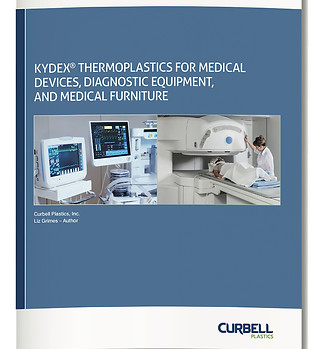New Materials Guide Highlights Thermoplastic’s Medical Applications
To disinfect medical equipment, hospitals use increasingly harsh cleaning agents on a regular basis, especially since the COVID-19 outbreak. As a result, equipment is cracking and breaking at an accelerated rate. Kydex thermoplastics have a unique blend of polymers that provide medical device and equipment manufacturers the desired physical durability against brittleness or discoloration from continuous chemical contact and wipe-down schedules, according to Curbell.
Most plastics use additive plasticizers that provide a nutrient source for microbial growth, said Curbell. However, Kydex thermoplastics do not include plasticizers in their chemical makeup and the material has been shown to prohibit bacterial and fungal growth.
Curbell adds that the material offers medical device manufacturers and hospital equipment providers with exceptional thermoforming capabilities in order to produce detailed part geometries. Products that are traditionally injection molded are often capable of being thermoformed with Kydex thermoplastics. Kydex sheet forms to deep draws, creating a more consistent product than other thermoplastics, and often resulting in fewer rejected parts, said Curbell.

Thermoforming Plastic Markets to 2024 - Increasing Demand of In-Mold Labeling in Packaging Creates Growth Opportunities
The thermoforming plastic market is expected to grow from USD 34.8 billion in 2019 to USD 45.9 billion by 2024, at a CAGR of 5.7% during the forecast period.
New product launches leading to an increased application scope of thermoforming plastic as well as the growing usage of these products across various end-use industries, including food & agriculture packaging, healthcare & pharmaceutical, construction, electrical & electronics, automotive packaging & structures, consumer goods & appliances, are expected to augment the market growth. However, the non-suitability of thermoforming plastic for the packaging of heavy items is the major factor restraining the growth of the market.
Automotive packaging & structures is the fastest-growing end-use industry of thermoforming plastic, in terms of value
Thermoforming plastic is gaining importance in the automotive packaging & structures end-use industry. Thermoformed plastic parts in the automotive sector are durable, reusable, and can be customized in any color. These parts do not require painting. Thermoformed parts are strong and can be reinforced. Some other properties include lightweight, easy to clean, and chemical resistance. Some of the major applications include dashboard assemblies, interior door panels, seating parts, engine bay paneling, exterior body panels, bumpers, air ducts, pickup truck bed liners, wheel well liners, truck liners, floor mats, and cargo mats.
The vacuum forming thermoforming plastic segment accounted for a major share of the thermoforming plastic market, in terms of value, during the forecast period
The global thermoforming plastic market is projected to be dominated by the vacuum forming thermoforming plastic segment, in terms of both value and volume during the forecast period. Vacuum forming is cost-effective, provides quicker tooling, and has the ability to form very large parts. This process also allows for sharper details, undercuts, mold-in-texture, and has tighter tolerances. Whereas pressure forming process is used mostly for complex shapes. The mechanical forming process is used rarely for thermoforming plastic.
North America is the largest, and APAC is the fastest-growing thermoforming plastic market
North America is the largest region in the thermoforming plastic market due to the high demand for thermoformed structural parts and thermoformed packaging from automotive, food & agriculture packaging, consumer goods & appliances, and healthcare industries. North America is home to some of the prominent thermoforming plastic manufacturers such as Pactiv LLC, Sonoco Products Company, D&W Fine Pack LLC, and so on. APAC is the fastest-growing region as the growing population presents a huge customer base for FMCG products and consumer durables, which in turn is expected to lead to the growth of the thermoforming plastic market.

Different Levels of Electronic Packaging
Electronics packaging design is organized in multiple levels namely Level 0 up to Level 5.
Level 0 – this electronic packaging level protects chips and semiconductors which are the simplest and most basic parts of an electronic system.
Level 1 – this electronic packaging level protects electronic components.
Level 2 – this electronic packaging level protects the printed circuit board.
Level 3 – this electronic packaging level protects assembly, wiring boards and associated components of these.
Level 4 – this electronic packaging level protects modules or collection of assemblies.
Level 5 – this electronic packaging level protects a combination of different modules or the electronic system in general.
These levels are necessary to help electronic manufacturing companies easily assess electronic packaging materials needed for an electronic packaging design. This makes operations more efficient and fluid since they can easily look for what they need simply by describing the electronic packaging level they are currently working on.

Oasis services
Various innovation plastic materials explored by our R&D team.From free samples to transportation, professional to do one-stop for material recommendation.

